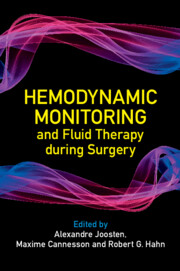Book contents
- Frontmatter
- Contents
- List of Contributors
- Foreword by Jean-Louis Vincent
- Preface
- Section 1 Hemodynamic Monitoring in the Perioperative Period
- Section 2 Basic Science & Concepts in Fluid Therapy
- 6 Body Volumes and Fluid Kinetics
- 7 Crystalloid Fluids
- 8 Colloid Fluids
- 9 The Role of Plasmatic Viscosity
- 10 Acid–Base Issues in Fluid Therapy
- Section 3 Practical Use
- Section 4 Future Directions
- Index
9 - The Role of Plasmatic Viscosity
from Section 2 - Basic Science & Concepts in Fluid Therapy
Published online by Cambridge University Press: 11 April 2024
- Frontmatter
- Contents
- List of Contributors
- Foreword by Jean-Louis Vincent
- Preface
- Section 1 Hemodynamic Monitoring in the Perioperative Period
- Section 2 Basic Science & Concepts in Fluid Therapy
- 6 Body Volumes and Fluid Kinetics
- 7 Crystalloid Fluids
- 8 Colloid Fluids
- 9 The Role of Plasmatic Viscosity
- 10 Acid–Base Issues in Fluid Therapy
- Section 3 Practical Use
- Section 4 Future Directions
- Index
Summary
The experimental microcirculatory analysis of treating anemia by blood transfusion shows that it minimally increases oxygen (O2) delivery by the capillary circulation, where O2 pressure (pO2), hematocrit (Hct) and capillary hydraulic pressure (pC) are normally 1/5 of systemic, and further depressed by anemia. The concomitant decrease of functional capillary density becomes lethal when falling below a specific threshold due to the decrease in pC, and requires re-pressurizing the microcirculation without increasing the heart’s work load. These effects are achieved by increasing plasma blood viscosity using a viscous plasma expander. This approach significantly elevates capillary blood viscosity and shear stress, increasing the production of the vasodilator NO, becoming significantbecause of the large capillary endothelial surface area, and because increased NO tends to lower O2 consumption. We show that using hyperviscous plasma expanders increases FCD, blood flow velocity and the rate of RBC delivery to the tissues. They could ultimately justify transfusing blood when DO2 falls to ¼ of normal, which is 4 times the normal organism metabolic requirement at rest.
- Type
- Chapter
- Information
- Hemodynamic Monitoring and Fluid Therapy during Surgery , pp. 96 - 104Publisher: Cambridge University PressPrint publication year: 2024

